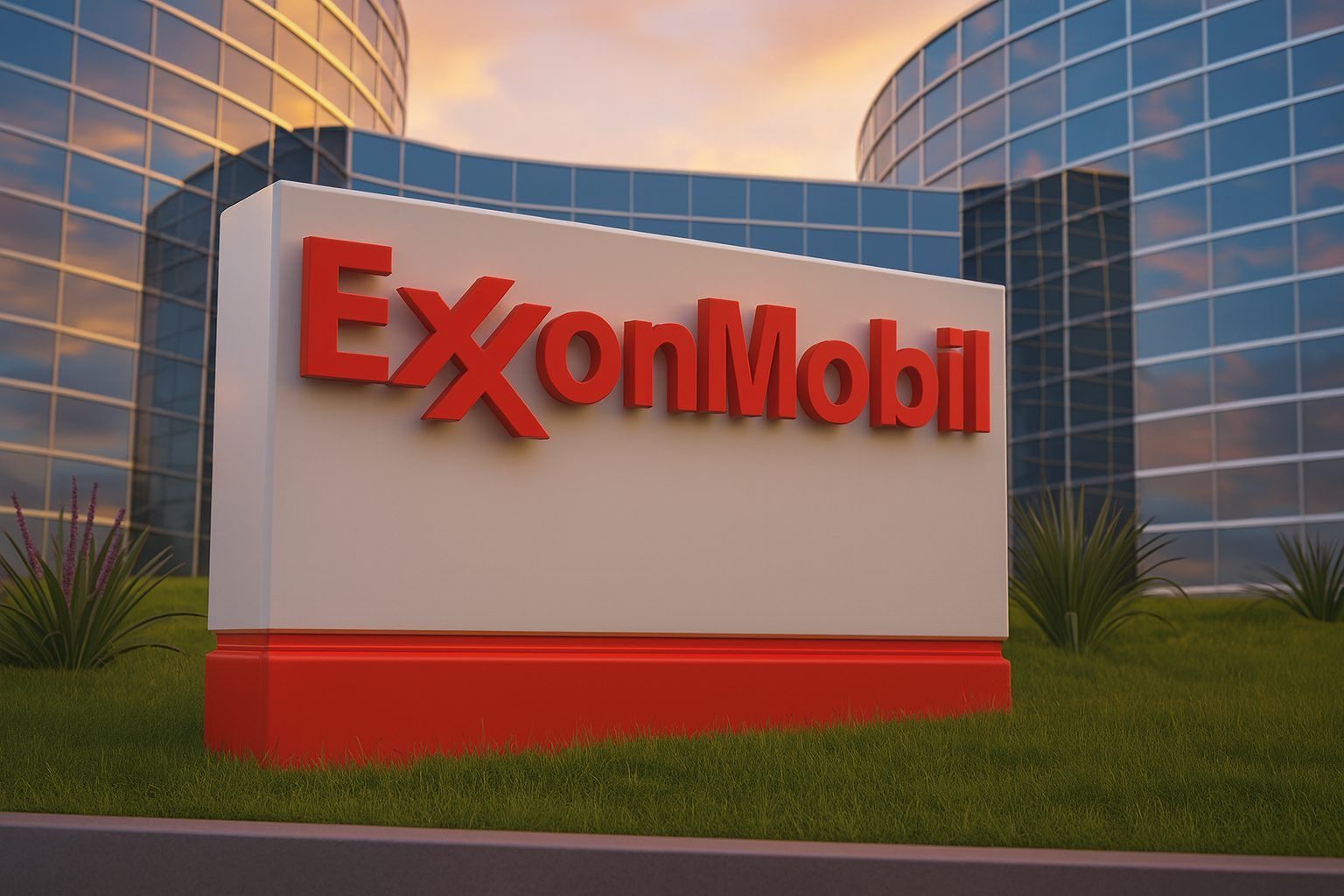Exxon Mobil Corporation (NYSE: XOM) traded around $115–116 per share on Friday, November 28, 2025, leaving the oil major broadly flat to modestly higher for the day as investors digested fresh research on its cash flows, a recently increased dividend, and a flurry of new institutional ownership disclosures. [1]
Below is a breakdown of all the key XOM stock headlines hitting the tape today and what they may mean for shareholders.
1. How Exxon Mobil Stock Is Trading Today
Market data providers show Exxon Mobil changing hands near $115.9 in Friday trading, with the forward annualized dividend at $4.12 per share, implying a yield of roughly 3.5–3.6% at current prices. [2]
A separate MarketBeat price snapshot tied to today’s filings notes that:
- Shares opened at about $114.93,
- Exxon’s market capitalization sits near $484–485 billion,
- The trailing P/E ratio is around 16.3, with a PEG ratio near 2.1,
- The 12‑month trading range runs from roughly $97.80 to $120.81,
- Balance sheet metrics remain conservative, with a debt‑to‑equity ratio of ~0.12 and current ratio about 1.25. [3]
Over the past six months, a Zacks analysis published via Nasdaq estimates that XOM shares are up about 12.9%, roughly in line with the broader oil & gas industry’s 13.3% gain over the same period. [4]
In short, Exxon Mobil is trading more like a steady compounder than a speculative oil play: modest price moves, high liquidity, and a large, sticky institutional shareholder base.
2. Zacks: Cash Flows Look Resilient Even if Oil Stays Soft
One of today’s most substantive pieces of coverage comes from Zacks Investment Research, published on Nasdaq under the headline “How ExxonMobil Plans to Sustain Cash Flows Amid Softer Crude Prices.” [5]
Key takeaways:
- Upstream remains the profit engine. Exxon still earns a large share of revenue and earnings from its upstream business, leaving it exposed to swings in crude and gas prices. [6]
- Low-cost barrels in Guyana and the Permian are the buffer. Zacks highlights Exxon’s “advantaged” assets in Guyana and the Permian Basin, where breakeven costs are low enough to keep projects profitable even if oil prices retreat. [7]
- Production ramp in Guyana: Management recently reported about 700,000 barrels per day of gross production in Guyana in Q3 2025 and has now sanctioned the seventh development, Hammerhead, expected to start up in 2029. Exxon aims to reach 1.7 million barrels of oil equivalent per day (boe/d) from eight Guyana developments by 2030. [8]
- More Permian acreage: Exxon further expanded its Permian footprint by acquiring over 80,000 net acres from Sinochem Petroleum, giving it more room to deploy its drilling technology and cost advantages. [9]
- Valuation and earnings estimates: Zacks pegs Exxon at about 7.5x EV/EBITDA, above the broader industry average around 4.8x, and notes that 2025 earnings estimates have been revised upward in the last week, even though it keeps the stock at a Zacks Rank #3 (Hold). [10]
The message from Zacks: Exxon’s low-cost barrels and cost-cutting programs put a floor under cash flows, but the stock already trades at a premium to peers, warranting a neutral stance from that particular research shop.
3. Q3 2025 Results: The Backdrop for Today’s Headlines
The current news cycle is happening against the backdrop of Exxon’s third-quarter 2025 earnings, reported on October 31. [11]
Highlights from the official company release:
- Q3 2025 earnings:$7.5 billion, or $1.76 per diluted share.
- Cash flow from operations:$14.8 billion in the quarter.
- Free cash flow:$6.3 billion.
- Shareholder distributions:$9.4 billion returned to investors in Q3 alone — about $4.2 billion in dividends and $5.1 billion in share repurchases.
- Operations:
- Record upstream production in both the Permian and Guyana, with net production hitting 4.8 million boe/d.
- The Yellowtail project in Guyana came online four months ahead of schedule, lifting installed capacity in the country to over 900,000 boe/d.
- Exxon also acquired 80,000+ net Permian acres from Sinochem and commissioned its Discovery 6 supercomputer to speed up reservoir analysis and exploration. [12]
These numbers help explain why, despite softer crude prices at times in 2025, analysts keep talking about “advantaged volumes” and structural cost savings as a major support for Exxon Mobil’s earnings power.
4. Dividend Story: Reliable Income, But Not the Highest Yield
Exxon Mobil is leaning into its dividend identity:
- The company raised its quarterly dividend from $0.99 to $1.03 per share, or $4.12 annualized. [13]
- The latest ex-dividend date was November 14, 2025, with payment scheduled for December 10, 2025. [14]
- At current prices, that works out to a forward yield around 3.5–3.6%, with a payout ratio close to 60%, leaving room for reinvestment in projects. [15]
Not everyone thinks XOM is the top dividend pick in Big Oil, though. A Seeking Alpha “Oil Dividend Roundup” article published today argues that Occidental Petroleum (OXY) now offers more attractive dividend metrics and clearer near-term catalysts than Exxon, even while acknowledging that both companies have solid sector positioning. [16]
Put simply:
- Income-focused investors may appreciate Exxon’s long history of consistent, growing dividends and strong balance sheet.
- Yield chasers, however, might tilt toward peers with higher payouts or more aggressive capital return programs, as some commentators suggest.
5. Big-Money Moves: Norges Bank Buys In, Others Take Profits
A major theme in today’s Exxon coverage is institutional positioning, with several new 13F-related headlines hitting on November 28:
Massive New Position from Norges Bank
- Norges Bank, Norway’s sovereign wealth fund, disclosed a new position of 57.2 million Exxon shares, valued at roughly $6.16 billion in Q2.
- The stake represents about 0.8% of Norges Bank’s portfolio, making Exxon its 15th-largest holding, and about 1.34% ownership of Exxon Mobil itself. [17]
This is a strong vote of confidence from one of the world’s largest and most conservative long-term investors.
Several Funds Trim Their XOM Stakes
On the other side of the ledger, multiple institutions disclosed reductions in their Exxon positions:
- Scotia Capital Inc. cut its Exxon stake by 10.4%, finishing Q2 with 239,288 shares valued at ~$25.8 million. [18]
- Boston Partners lowered its holding by 4.7%, ending the quarter with 484,197 shares worth about $52.2 million. [19]
- Virtue Capital Management LLC reduced its position by 49.2%, ending with 9,601 shares worth around $1.0 million. [20]
- F m Investments LLC slashed its stake by 61.7%, finishing with 50,359 shares valued at roughly $5.4 million. [21]
Most of these reports also note that around 61.8% of Exxon’s stock is owned by hedge funds and other institutions, underscoring how heavily professional investors dominate the shareholder base. [22]
How to read this:
- The Norges Bank purchase suggests that some large, long-horizon investors see Exxon as a core, defensive energy holding with dependable cash returns.
- The smaller trims from asset managers like Scotia Capital, Boston Partners, Virtue, and F m Investments likely reflect portfolio rebalancing or profit-taking, not necessarily a fundamental rejection of Exxon’s story.
6. Oil Market Backdrop: Why XOM Is an “Oil Stock to Watch”
Today’s trading is also being influenced by the broader oil market narrative:
- A TradingView news brief notes that Exxon’s stock “saw a slight increase” as oil prices ticked higher, with Brent crude around $62.97 per barrel and WTI near $59.24 ahead of an upcoming OPEC+ meeting. [23]
- The same note points out that Exxon is supplying a January-loading Upper Zakum crude cargo to TotalEnergies, having sold eight cargoes totaling around four million barrels for the month, underscoring its role in global crude flows. [24]
Meanwhile, MarketBeat’s “Oil Stocks To Watch Today – November 28th” highlights Exxon Mobil, Chevron, ConocoPhillips, EQT, and Petrobras as the top five oil names by dollar trading volume in recent sessions — a reminder of how central XOM remains to energy-focused strategies. [25]
Kalkine Media also describes Exxon Mobil’s stock as “stable” amid gains in the NYSE Composite index, emphasizing its diversified segments (upstream, energy products, chemicals, specialty products), robust operations, and long record of dividend payments. [26]
The takeaway: XOM continues to trade like a bellwether for the oil patch, moving in step with crude prices but cushioned by scale, integration, and investor perception as a defensive blue‑chip.
7. Regulatory and Strategic Backdrop: Pioneer Deal and FTC Scrutiny
Exxon’s long-term strategy still revolves around scaling low-cost production, especially in the Permian Basin and Guyana.
- The company completed its acquisition of Pioneer Natural Resources in May 2024, in a deal valued at nearly $60 billion, more than doubling its Permian production footprint. [27]
Regulators have continued to scrutinize aspects of the transaction:
- On July 17, 2025, the U.S. Federal Trade Commission (FTC) announced that it had reopened and set aside its prior consent order related to Exxon’s proposed acquisition of Pioneer Natural Resources, though the case file is currently listed as closed. [28]
While this is not front-page news today, it remains part of the regulatory overhang investors are watching. For now, however, Exxon is operating the combined Permian business and integrating Pioneer’s acreage, which is feeding the production growth and cash flow resilience analysts highlighted in today’s reports.
8. What Today’s News Means for XOM Investors
Putting all of November 28’s headlines together, a few themes emerge:
1. Cash flows look sturdy even if oil is choppy
Advantaged volumes in Guyana and the Permian, combined with record refining throughput and ongoing cost reductions, support the idea that Exxon can maintain strong cash generation through cycles. [29]
2. Dividend reliability over maximum yield
With a freshly raised dividend, forward yield in the mid‑3% range, and a payout ratio around 60%, Exxon is positioning itself as a “sleep-at-night” income stock rather than the highest-yielding oil name. Some analysts prefer Occidental for pure dividend upside, but Exxon’s stability and balance sheet strength keep it on many dividend investors’ short lists. [30]
3. Institutions are actively repositioning — but not abandoning — Exxon
The Norges Bank purchase is a major endorsement, while multiple smaller managers have trimmed positions and locked in gains. Overall institutional ownership remains high, at around 62% of shares outstanding. [31]
4. Valuation sits in a “quality at a reasonable price” zone
A P/E near 16x and EV/EBITDA around 7.5x, modest premium to the sector, suggests investors are willing to pay up for Exxon’s scale, diversification, and project pipeline, but are not treating it like a hyper‑growth story. [32]
5. Key risks to monitor
- Prolonged weakness in oil and gas prices could eventually pressure earnings, despite advantaged barrels. [33]
- Continued regulatory scrutiny around large mergers and environmental issues could impact capital allocation and future deals. [34]
- Execution risk on major projects (Guyana developments, Permian integration, energy transition initiatives) remains, though Exxon’s track record is strong.
9. Bottom Line
As of November 28, 2025, Exxon Mobil stock remains a cornerstone holding in the global energy sector:
- Price action: trading around the mid‑$110s, relatively stable. [35]
- Fundamentals: strong Q3 cash flows, rising production from low-cost assets, and a growing portfolio of high-value downstream and specialty products. [36]
- Shareholder returns: a rising dividend, active buybacks, and ongoing commitment to capital discipline. [37]
- Ownership & sentiment: heavy institutional presence, a new multibillion-dollar stake from Norges Bank, and a “Moderate Buy” consensus rating with an average price target around $128.67. [38]
For investors, today’s news flow reinforces the picture of Exxon Mobil as a large, steady cash engine rather than an explosive growth story—a stock that may appeal most to those seeking defensive energy exposure plus dependable income, while traders continue to key off oil prices, OPEC+ headlines, and upcoming earnings catalysts.
References
1. www.tradingview.com, 2. www.dividend.com, 3. www.marketbeat.com, 4. www.nasdaq.com, 5. www.nasdaq.com, 6. www.nasdaq.com, 7. www.nasdaq.com, 8. www.nasdaq.com, 9. www.nasdaq.com, 10. www.nasdaq.com, 11. corporate.exxonmobil.com, 12. corporate.exxonmobil.com, 13. www.marketbeat.com, 14. www.tipranks.com, 15. www.dividend.com, 16. seekingalpha.com, 17. www.marketbeat.com, 18. www.marketbeat.com, 19. www.marketbeat.com, 20. www.marketbeat.com, 21. www.marketbeat.com, 22. www.marketbeat.com, 23. www.tradingview.com, 24. www.tradingview.com, 25. www.marketbeat.com, 26. kalkinemedia.com, 27. corporate.exxonmobil.com, 28. www.ftc.gov, 29. www.nasdaq.com, 30. seekingalpha.com, 31. www.marketbeat.com, 32. www.nasdaq.com, 33. www.nasdaq.com, 34. www.ftc.gov, 35. www.dividend.com, 36. corporate.exxonmobil.com, 37. corporate.exxonmobil.com, 38. www.marketbeat.com








